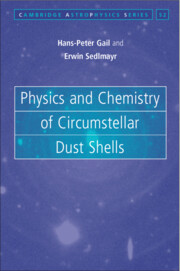Book contents
- Frontmatter
- Contents
- Preface
- Part I Setting the Stage
- Part II Theoretical Description of Circumstellar Dust Shells
- 3 Theory of Circumstellar Dust Shells
- 4 Energy Equation for Matter
- 5 Radiative Transfer
- 6 Interaction between Gas and Dust Particles
- 7 Extinction by Dust Grains
- 8 Approaches to the Temperature Equations
- 9 Chemistry in Thermodynamic Equilibrium
- 10 Gas-Phase Chemical Composition
- 11 Gas-Solid Chemical Equilibria
- 12 Growth of Dust Grains
- 13 Formation of Seed Nuclei
- 14 Moment Equations
- Part III Applications
- Part IV Appendices
- Bibliography
- Index
- Miscellaneous Endmatter
7 - Extinction by Dust Grains
from Part II - Theoretical Description of Circumstellar Dust Shells
Published online by Cambridge University Press: 18 December 2013
- Frontmatter
- Contents
- Preface
- Part I Setting the Stage
- Part II Theoretical Description of Circumstellar Dust Shells
- 3 Theory of Circumstellar Dust Shells
- 4 Energy Equation for Matter
- 5 Radiative Transfer
- 6 Interaction between Gas and Dust Particles
- 7 Extinction by Dust Grains
- 8 Approaches to the Temperature Equations
- 9 Chemistry in Thermodynamic Equilibrium
- 10 Gas-Phase Chemical Composition
- 11 Gas-Solid Chemical Equilibria
- 12 Growth of Dust Grains
- 13 Formation of Seed Nuclei
- 14 Moment Equations
- Part III Applications
- Part IV Appendices
- Bibliography
- Index
- Miscellaneous Endmatter
Summary
The absorption and scattering properties of dust grains strongly depend on the ratio of the particle size to the wavelength of the wave interacting with a grain. Generally it is assumed that most of the grains in circumstellar dust shells are much smaller in size than 1 μ m but that some fraction of the grains has sizes up to a few microns (cf., e.g., Jura 1996). This assumption is based on (1) the observation that circumstellar grains seem not to strongly scatter radiation in the visual and infrared wavelength regions, but that scattering becomes important in the ultraviolet (UV) region (cf. Kruszewski et al. 1968; Serkowski and Shawl 2001) and (2) the theory of scattering of electromagnetic radiation by small particles that shows particles to strongly scatter radiation only if their size is comparable with or larger than the wavelength of radiation. The typical wavelengths of the radiation emitted by stars and their circumstellar dust shells considerably exceed the size of most of the grains, and one can determine the extinction properties of the dust in the limit case of small particles. Only if one is interested for some reason in the UV part of the spectrum has one to consider the case of grains bigger than the wavelength, but even then the particles are not very big compared with the wavelengths. In the theory of circumstellar dust shells there is fortunately no need to consider really big grains, and one avoids the problems encountered by calculating their extinction properties.
- Type
- Chapter
- Information
- Physics and Chemistry of Circumstellar Dust Shells , pp. 167 - 215Publisher: Cambridge University PressPrint publication year: 2013

